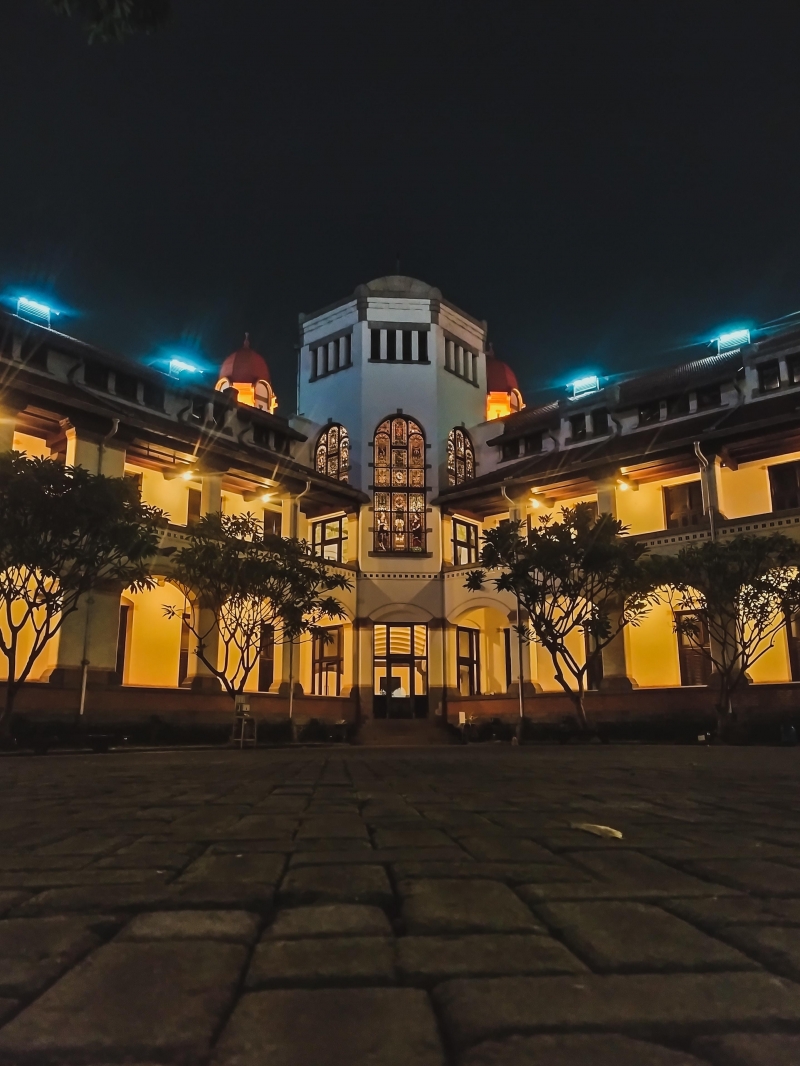Immerse in The Enchanting Java Culture in Central Java

Blessed with diverse culture and spectacular nature, Indonesia has attracted visits from tourists from all over the world. Although most tourists choose to spend their vacation in the world renowned Bali island, other cities, and islands in Indonesia also have a lot of fascinating sides to offer, such as mainland Java, home to more than half of Indonesia's population and the center of Indonesia's political and cultural.
The Java culture is arguably one of the predominant and most influential cultures in Indonesia. It has a rich history and tradition that has had a significant impact on the development of Indonesian culture as a whole. The Javanese culture is alive and thrives in each city in mainland Java with Central Java as the Javanese cultural heartland. When you're traveling around Central Java, you can interact with locals, taste the cuisine, learn the language, visit historical sites & landmarks, and admire the natural wonders.
SEMARANG CITY
Semarang is not only the largest city in the province but also its capital. It is a bustling urban center with a rich history and serves as an important hub for trade, industry, and culture in Central Java. Here are some attractions you can visit in Semarang:
Sam Poo Kong Temple:
1. Sam Poo Kong, also known as Gedung Batu Temple, is a significant historical and religious site in Semarang. It is a Chinese temple that dates back to the 15th century and is dedicated to Admiral Zheng He (Cheng Ho), a Chinese explorer who visited Java during his voyages.
The temple complex consists of several buildings, including a main temple, a pagoda, and a museum. It features a mix of Javanese and Chinese architectural styles, making it a unique and visually appealing site. You can explore the temple grounds, view ancient artifacts and Chinese cultural displays in the museum, and appreciate the peaceful atmosphere. The temple is often a place of worship for both Buddhists and followers of Confucianism.
2. Lawang Sewu, which translates to "Thousand Doors," is an iconic colonial-era building in Semarang. It was constructed by the Dutch East Indies Railway Company and served as the company's headquarters.
The building is renowned for its striking architecture, including numerous arched doorways and windows. Despite the name, it doesn't actually have a thousand doors; the name is symbolic and represents the grandeur of the structure. Today, Lawang Sewu is open to the public as a museum. You can explore the building's interior, which houses historical exhibits related to the history of the railway company and Dutch colonial heritage. It is also known for its unique underground tunnels.
3. Semarang Old Town, also known as Kota Lama, is a historic district that showcases Dutch colonial architecture. It's a charming area filled with well-preserved buildings from the colonial era, offering a glimpse into Semarang's past. The area is known for its colorful, colonial-style houses, canals, and quaint streets. Some of the prominent buildings in Semarang Old Town include Blenduk Church (Gereja Blenduk), the Semarang Post Office, and Tawang Railway Station. You can take leisurely walks through the streets of Semarang Old Town, appreciating the unique blend of Dutch and Indonesian architectural elements. It's also a great place for photography, and there are cafes and restaurants where you can enjoy local cuisine.
4. Gedongsongo Temples, a complex of Hindu temples located in Central Java, Indonesia, near Semarang. These temples are nestled on the slopes of Mount Ungaran and are renowned for their scenic and tranquil setting.
The Gedongsongo Temples date back to the 8th and 9th centuries during the Sanjaya dynasty of the Mataram Kingdom. They are believed to be one of the oldest Hindu temple complexes in Central Java, predating the construction of the famous Prambanan and Borobudur temples.
5. Ambarawa Coffee Plantation, often known as Ambarawa Coffee, is a coffee plantation located in the Ambarawa region of Central Java, Indonesia. Coffee is an important agricultural crop in Indonesia, and Ambarawa is one of the areas known for its coffee production, particularly the Arabica variety. The coffee plantation is set in a picturesque location with rolling hills and lush landscapes. The surrounding area offers beautiful views of the plantation, making it a pleasant spot for you to enjoy the natural beauty.
MAGELANG
1. Borobudur Temple, a magnificent Buddhist temple located in Central Java, Indonesia. It is one of the most iconic and important religious monuments in the world and is often considered one of the Seven Wonders of the World. Borobudur was designated as a UNESCO World Heritage Site in 1991. It is recognized for its historical and cultural significance as one of the most important Buddhist monuments in the world.
Built during the 9th century, around 800-850 CE, during the reign of the Sailendra dynasty, Borobudur is a massive, pyramid-shaped temple complex consisting of nine stacked platforms. It is considered a microcosm of the Buddhist universe and is designed to represent the path to enlightenment in Buddhist cosmology. Pilgrims traditionally circumambulate the temple, following a path that symbolizes the spiritual journey from ignorance and suffering to enlightenment and nirvana. As a major tourist attraction in Indonesia, Borobudur draws visitors from around the world who come to appreciate its architectural beauty, historical significance, and spiritual atmosphere. It offers stunning sunrise and sunset views and you can explore the temple's many levels and galleries.
Besides, the Borobudur temple, you can also explore the smaller temples Mendut and Pawon which are located at the same compound.
2. Ketep Pass, or Ketep Volcano Observation Post is a popular tourist destination in Magelang Regency, Central Java, Indonesia. It is known for its panoramic views of the surrounding volcanoes and is a prime spot for observing the majestic Mount Merapi, an active stratovolcano. The area around Ketep Pass offers opportunities for hiking and trekking. You can explore the scenic trails and get closer to the natural beauty of the region. Ketep Pass is also a popular location for sunrise and sunset viewing. The changing colors of the sky, especially around the volcanic peaks, create stunning visual experiences for visitors.
SOLO CITY
Solo City also known as Surakarta, is a city located in Central Java, Indonesia. It is often considered one of the cradles of Javanese culture. Solo is one of the region's major cities and is known for its rich cultural heritage, particularly in Javanese traditions and the arts. Here are some attractions in Solo:
1. Royal Mangkunegaran Palace (Pura Mangkunegaran), located in the heart of Solo, near the Surakarta Palace (Keraton Surakarta), The Mangkunegaran Palace was established in the 18th century as a result of a division within the Surakarta Sultanate. It was created for Mangkunegara I, a prince who wanted to rule independently from the Surakarta Sunanate. The palace is a fine example of Javanese court architecture and features a blend of Javanese, Dutch, and Chinese architectural styles. It includes a grand pendopo (Javanese pavilion), a beautiful courtyard, and elaborately decorated structures. The palace is not only an architectural gem but also a cultural treasure. It houses a collection of Javanese art, including traditional wayang kulit puppets, gamelan music instruments, and other royal artifacts.
2. Triwindu Market, situated in the center of Solo, not far from the Mangkunegaran Palace. The market is known for its historical significance and has been a trading hub for antiques, vintage items, and collectibles for many years. Triwindu Market is famous for its wide array of antiques and collectible items, including vintage toys, ceramics, batik, furniture, coins, and more. It's a haven for antique enthusiasts and collectors.
3. Sukuh Temple, a Hindu temple that dates back to the 15th century, during the late Majapahit period. Its architecture and carvings are distinctive and have sparked various interpretations of their symbolism and cultural influences. The temple's architecture is unique and includes erotic reliefs and a step pyramid structure that is reminiscent of ancient Mesoamerican pyramids. These features make Sukuh Temple quite different from other Javanese Hindu temples. Sukuh Temple is situated on the slopes of Mount Lawu in the Karanganyar Regency, not far from Solo.
YOGYAKARTA CITY
Yogyakarta, often simply called "Jogja," is a vibrant and culturally rich city located in the southern part of the island of Java, Indonesia. It is known for its historical and cultural significance, stunning landscapes, and a blend of traditional and contemporary elements. Here are some of the attractions you can visit in Yogyakarta:
1. Prambanan Temple, a 9th-century Hindu temple complex is one of the most important archaeological and cultural sites in Indonesia. It was built during the Mataram Kingdom's reign and is dedicated to the Hindu trinity of Brahma, Vishnu, and Shiva. The temple complex is renowned for its towering spires and intricate stone carvings. The grandeur of the architecture reflects the importance of Hinduism in ancient Java.
In the evenings, Prambanan often hosts cultural performances, including the Ramayana Ballet, which narrates episodes from the Indian epic Ramayana using dance and traditional Javanese music.
2. Taman Sari Water Castle, was built in the mid-18th century during the reign of Sultan Hamengkubuwono I. It was originally designed as a royal garden and bathing complex for the royal family. The site features a unique combination of Javanese and European architectural styles. It includes a series of bathing pools, underground tunnels, and decorative pavilions. The central feature of the complex is the Umbul Pasiraman, a large pool where the sultan and his consorts would bathe.
3. Yogyakarta Kraton (Sultan's Palace). The Kraton is the royal palace of the Sultan of Yogyakarta and has been the seat of the Yogyakarta Sultanate since the mid-18th century. It is an important center for Javanese culture, tradition, and governance. The Kraton is not only a historic residence but also a living museum of Javanese culture and the Sultanate's traditions. You can explore the palace's structures, artifacts, and watch cultural performances.
Central Java is a region where you can immerse yourself in the enchanting world of Javanese traditions, appreciate the beauty of its culture, and explore the historical significance of the region. It offers a unique and authentic Indonesian experience for travelers interested in art, culture, and history.
Dada Sabra S.
Log on theislandgirladventures for more interesting travelstories
image by Visual Karsa on Unsplash">Visual Karsa
-----------------------------------------------------------------------------------------------------------------------------------------------------------------
Intrested in visiting this amazing sight ? Check out what Perama Tour Have to offer !
